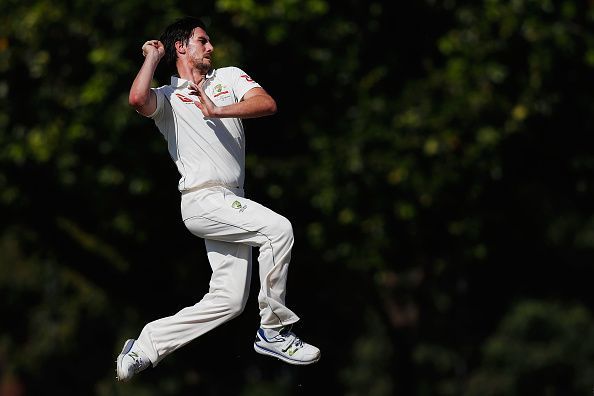
Under the SKanner: Pat Cummins

Going into the 2017/18 edition of the Ashes, the focal point on Australia will be their potent pace attack comprising of quite a few world-class bowlers. Going by their recent form and ability to wreak havoc on pitches at home, England's batsmen could have a tough challenge on their hands.
Adding to the visitors' woes will be a fit and firing Pat Cummins. After being out of the limelight for some time due to back injury as well as stress fracture, Cummins came into the Australian team earlier this year.
His height, smooth action and capacity to bowl at 90 mph on a regular basis have earned him respect from many experts. The right-armer's performances on slow pitches in India and Bangladesh have increased his value as an impact bowler. He has grown in stature over the last few months and his confidence would be a great asset for Australia who are eager to reclaim the Ashes.
Also Read: Ashes 2017/18 - Australia announce 13-man squad for first two Tests
In this segment, Let us take a look at the strengths and weaknesses of Cummins in Test cricket.
Strengths
Ability to adapt to different conditions

Every bowler has to perform in different conditions to sustain his career at the international level. While some bowlers are reasonable successful overseas, Cummins has shown that he can bowl in tough bowling conditions pretty well.
His biggest strength is to hit the deck hard and extract bounce from the pitch when the ball is new. By doing that, he causes trouble for the opposition as they have to negotiate some quick fire swinging deliveries at the beginning of the innings.
And Cummins adjusts to conditions rather well. His rapid spells on the slow pitches in the subcontinent ensured that the pressure was maintained for Nathan Lyon to attack from the other end.
It’s this quality which makes him such a key player to have in the bowling attack. As he gauges the conditions quickly and mixes up his deliveries, he adapts his game to different surfaces.
From five tests (four of which came in the sub-continent), he has got an impressive 21 wickets at an average of 25.95 with one five wicket haul. Australia would be confident that he can replicate his overseas form in the comforts of home when the Ashes kicks off.
Capacity to generate conventional and reverse swing
Cummins is the full package. He is tall, athletic and has a smooth bowling action. His ability to constantly bowl over 140 kph makes him a threat even when the pitch is slow, low and has nothing in it to offer for the fast bowlers.
Apart from making the new-ball talk, he also has the natural ability to get swing movement with the older one. That swing movement keeps the batsmen on their toes as they are not sure which ball would move away or in to their pads. This adds to his quality as a bowler.
And after viewing the test matches in India and Bangladesh, one can say that he has got the skills to make use of the dryness and weariness of the pitch to get reverse swing. His reverse swinging yorkers may not be as lethal as that of Mitchell Starc’s but it is still a big surprise element which he can introduce at any point in time.
Overall, it’s a promising sign for Australian cricket to see a young fast bowler swing the ball both ways and return to reverse the older one.
Quick and accurate bouncers
Every fast bowler has one lethal delivery in their armory which is their biggest strength . While Mitchell Starc has the yorker which he bowls at will and James Anderson has the ability to swing the ball away from the bat beautifully, Cummins has the bouncer.
His bouncer is accurate, aimed at the helmet of the batsman and is bowled at speeds of 145 kph or higher. Batsmen are not sure whether to attack or defend those bouncers. Since its very accurate, it gets tough for them to duck and leave them away.
In recent times, bowlers like Stuart Broad and Umesh Yadav come to mind while discussing about the quality of bouncers. Cummins enjoys bowling them and has already said that the England batsmen need to come prepared to handle the barrage of bouncers which could come their way.
Weaknesses
A bit one-dimensional on conditions that don’t suit him
Pat Cummins in his short career so far has shown lot of promise. But if he has to change something in his bowling, it would have to be his tendency to be a bit one-dimensional.
He relies too much on the bouncers or the fuller ones which swing away from the batsmen. Once they negotiate his early spells, then quality batsmen like Joe Root and Alastair Cook can score freely against him.
Since his strengths lie in his pace and the ability bowl accurate bouncers, Cummins starts tiring a bit after getting through his initial spells. Hence, he tends to get predictable and looks to pitch the ball up in the hope of extracting swing.
If batsmen can handle his first spell without too much problem, then there are chances that Cummins can spray the ball around a bit in his quest for wickets. In such times, the opposition can capitalise and attack him.
Prone to getting injured frequently

Cummins burst on to the international scene in 2011. Most people felt that he would go on to play lot of games since then especially in Test cricket. His potential and skill was evident for everyone to see.
But sadly, owing to multiple injuries which he has suffered, Cummins has played only 5 Tests, 36 ODIs and 18 T20Is thus far. Stress fracture and back injuries have hampered his international career thus far.
In fact, frequent injuries are a major problem which has impacted Australia a lot in recent times. Promising bowlers like James Pattinson, John Hastings, and Nathan Coulter-Nile have suffered injuries. As a result, the balance of the team in all formats of the game gets affected.
Extra Cover: Under the SKanner - Murali Vijay
Managing the workload of their fast bowlers has proved to be a challenge in recent times for Australia. The likes of Starc and Hazelwood have had to play in all formats of the game which takes a lot of physical strength.
Cummins has also been prone to getting injured a lot in his career so far. If Australia want to groom him so that he can play across all formats more frequently, then they must ensure that the 25-year old manages his workload to avoid breaking down on a regular basis.